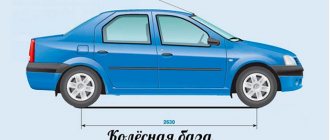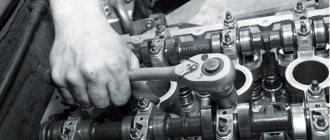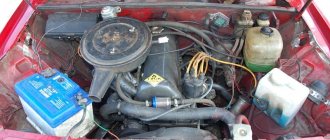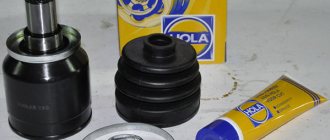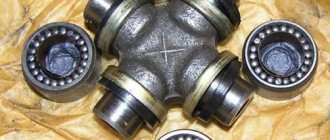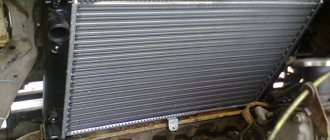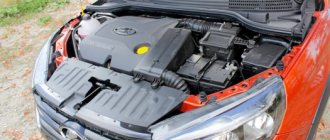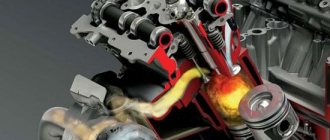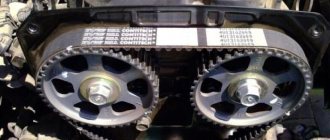When choosing a car, each buyer is guided by an extensive list of criteria and requirements that the car must meet. Among these parameters, the concept of power plant resource almost always appears.
This is a really important characteristic that largely allows you to understand how long a particular vehicle can be used.
Although the engine life is largely a conditional parameter, it is capable of reflecting the capabilities of the car. It’s not for nothing that the engine life is indicated in the official documents for the car, and the automaker also strives to achieve the maximum values of this characteristic.
What it is
Resource refers to the lifespan of automobile engines. It is important to clarify that here we are talking about the maximum number of kilometers that a vehicle can travel before the moment when a major overhaul of the power plant is required.
The conventionality of the value is explained by the fact that the service life largely depends on the immediate operating conditions of the vehicle. If these are normal conditions without strong overloads and extreme loads, the car will easily overcome the maximum mileage stated by the manufacturer. But with aggressive driving and constant operation of the engine under load, the resource will end earlier. Also, the service life is negatively affected by all sorts of technical improvements aimed at increasing power and performance at the expense of reliability and durability.
Because of this, the same car with similar characteristics, but under different operating conditions, can exhaust its service life in 100-150 thousand kilometers, or drive more than 500 thousand, and only then require major repairs. And sometimes even more.
In most cases, car companies themselves indicate only the warranty period. That is, the mileage during which the engine will not suffer if all prescribed operating rules are followed. But the real and complete resource is much greater than the warranty.
Using the example of cars produced by AvtoVAZ, we can say that the first models, called classics, had a warranty service life of 125 thousand kilometers. When the VAZ 2110 and its brothers appeared, the service life was increased to 150 thousand kilometers.
But everyone knows very well and has personally observed how hundreds, and sometimes thousands of AvtoVAZ cars drive on Russian roads, the odometer numbers of which have gone well beyond 200-300 thousand kilometers. At the same time, the cars themselves are in adequate condition, there are no hints of major repairs.
Relatively recently, foreign car companies decided that it was necessary to create engines that could operate without failure throughout the entire service life of the car itself. This is how the so-called millionaires began to appear. That is, the resource of such engines was designed to cover 1 million kilometers.
But such a policy turned out to be short-lived. Having carefully reviewed our approach to production, the vector has changed to the opposite. Automakers realized that in order to increase earnings, it was more profitable for them to reduce engine life. This will lead to the need to buy spare parts, as well as change cars more often. Hence the increase in sales.
As a result, companies abandoned million-plus engines and began to artificially reduce their service life. For modern foreign-made cars, the standard service life is about 300 thousand kilometers. Moreover, such parameters are relevant for the service life of diesel engines and gasoline power plants.
There are several characteristic signs indicating that the car is gradually wearing out the life of its engine, and therefore requires repair. This can be determined by:
- increased fuel consumption;
- active consumption of motor oil;
- loss of power;
- extraneous knocking noises in the engine.
This does not yet indicate a major overhaul. It’s not that car owners do it while continuing to operate their car. In most cases, they try to get rid of a car whose service life is coming to an end and buy something more recent among offers on the secondary market, or even buy new cars from the showroom. This already depends on specific financial capabilities.
Let's sum it up
Modern engines do not always show the same service life as older million-ton units. But many factors of increased wear and premature death of units depend on the owner himself. For example, a machine with constant high-quality service feels great and runs smoothly to the end of its factory life without expensive breakdowns. Saving on relatively inexpensive filters and oils leads to the fact that the power unit operates in an atmosphere that is not suitable for itself, and therefore wears out faster. This causes a serious reduction in resource.
Drivers also fill their engines with something unknown, drive on the same oil for several years, kill power units with prolonged warm-up or no warm-up at all, use all sorts of additives “to reduce fuel consumption,” and go to garage service stations. All this little by little (and sometimes a lot) kills the engine and causes the deadline for its replacement or serious overhaul to approach. So you should pay close attention to maintenance issues and, in general, operating modes of the power unit. In this case, the engine in your car will last much longer. What are you doing to increase the resource of the power plant?
Resource depending on engine type
In many ways, the service life of engines can be judged by what type of power plants a particular unit belongs to.
Despite the fact that the resource for modern engines is about 300 thousand kilometers, this is an average value. For a more accurate determination, it is important to consider what type of motor we are talking about in a particular case.
Companies do not openly admit this, but in reality, for new passenger cars, the service life of installed engines is artificially reduced. How exactly this is done is up to each manufacturer to decide for himself. But for modern cars, this phenomenon has become the norm.
Therefore, it is quite natural that car enthusiasts are actively interested in which engine designed for a passenger car has the longest resource.
The question is more than fair, since rotary, two-stroke, four-stroke and other power units really have different safety margins. Using the example of different types of engines, it is worth finding out what the service life is in a particular engine, and how the service life of a gasoline engine differs from a diesel engine.
- The smallest safety margin is observed in two-stroke engines running on gasoline, which are installed on motorcycles. This is due to very high crankshaft speed parameters. There is also virtually no lubrication system, which also negatively affects the lifespan. To lubricate the cylinder-piston group, a mixture of fuel and oil is used. By changing the operating mode, such engines require different amounts of lubrication, but the motor system cannot change this parameter. That is, the engine is normally lubricated when only in certain operating modes. When the load is increased, the effect of oil starvation is observed. Hence the small resource.
- Rotary power plants perform noticeably better. Currently, such engines are rare. There is only one automaker that uses rotary internal combustion engines in series. This is the Japanese company Mazda. Moreover, they are available on a limited number of models. The engine life in this case exceeds two-stroke engines, but is inferior to classic four-stroke solutions. Even if the rotor system is properly and promptly maintained, its service life will not exceed 100-150 thousand kilometers. But since such engines are installed on production sports cars, the actual mileage before major repairs is usually no more than 75 thousand kilometers.
- Four-stroke petrol. These engines are superior in terms of service life to both previously discussed engines. Moreover, the engine life of foreign cars is longer than that of domestic designs. But even in this situation, the lifespan is hundreds of thousands of kilometers. It’s not that uncommon for four-stroke bikes to travel over 500 thousand kilometers. Similar parameters are relevant for all types of four-stroke gasoline engines, regardless of the cylinder layout used.
- Boxer power plants. A characteristic feature of Japanese cars produced by Subaru. Owners of these cars often claim that boxer units are very durable and are supposedly superior to competitors of the four-stroke gasoline type. But there are no significant and fundamental differences in terms of service life between these units. Therefore, it is unfair to say that boxers have a long service life. Plus, classic four-stroke engines are simpler in design, which simplifies their maintenance and reduces the cost of repair work.
- Turbocharged engines. If we talk about their durability in relation to turbo engines, then the main attention is paid to the service life of the turbine itself. It cannot boast of long-term trouble-free operation, although the engine itself can continue to perform its functions efficiently for a long time. But as soon as you remove the turbine from the turbo engine, it turns into a standard and most common naturally aspirated engine. The average turbine service life is 100 thousand kilometers. After this, it needs to be repaired, but more often the element is completely replaced. The more correctly the driver adheres to the recommendations for operating a turbo engine, which differ from atmospheric analogues, the longer the turbocharged power plant will last.
- Diesel engines. These are motors with the longest service life and safety margin. There are explanations and reasons for this. To begin with, high-strength alloys are used in the production of diesel engines, which is due to the increased compression ratio. Plus diesels are slower. We're talking about revolutions. If standard gasoline engines usually move at a speed of 3-4 thousand units in operating mode, for a diesel engine the current figure is 1.5-2 thousand revolutions. In other words, with equal mileage, the pistons on a diesel power plant perform 2 times less reciprocating movements than on gasoline counterparts. And this directly affects physical wear and tear.
Interesting
The world in which car owners live is full of legends and rumors. Quite a lot of them are devoted to the reliability of car engines. For example:
- there is a legend about an engine that does not break down;
- many car enthusiasts can talk for hours about engines they know with mileage of more than 1 million km;
- There were “reliable” rumors that the American company Rolls-Rouce produces engines, inside of which a flask with abrasive material breaks after a certain mileage. As a result, the power unit instantly fails and cannot be repaired.
Ways to increase motor life
Motorists who truly love, value and cherish their vehicle are looking for useful tips on extending the life of the engine.
If we talk about serial civilian cars, which are mainly used in urban conditions and on highways, and periodically go on light off-road conditions outside the city, we can give 8 useful recommendations. These tips are hardly relevant for sports cars, since the requirements for them are very specific. And such cars are operated in completely different conditions.
If you want to increase the service life of the motor, pay attention to the following nuances:
- running-in process;
- instructions;
- oil;
- cooling fluids;
- fuel;
- operating modes;
- catalyst;
- vibrations;
- isolation of liquids.
To clarify each of these points, we need to consider them separately.
Liquid isolation
No one argues that only high-quality working fluids should be poured into the engine. This is a truth that hardly needs to be reminded.
But some people forget about the importance of avoiding mixing different formulations. That is, all liquids must be isolated from each other. This mainly concerns oil and coolant.
When traces of oil are found in the coolant reservoir, or an emulsion appears in the engine lubricant due to the coolant, this is an extremely alarming signal. Mixing these components will certainly lead to premature engine wear.
If you ignore such symptoms, you will bring your own hands closer to the moment when you will need to make expensive major repairs. Moreover, it comes much faster than car owners often expect.
Vibrations and catalyst
When the engine begins to make uncharacteristic sounds and at the same time vibrates, urgent and mandatory diagnostics are required.
With strong vibrations, the engine wear rate increases several times. Even fully serviceable parts can completely wear out and fail in a short period of time.
Also dangerous is the breakdown of the catalyst, which performs the function of cleaning the exhaust generated by the engine when burning the air-fuel mixture. Failure of this element leads to corrosion, clogged oil filter and other negative consequences.
Just a few hours of operation, a car with a broken catalyst reduces its service life by several tens of thousands of kilometers.
Operating mode
The service life of the engine directly depends on the conditions in which the car is operated. And here there are several situations when the mode is definitely not good for the engine:
- Long stops with occasional short distances. This is a characteristic feature when operating in a big city in dense traffic conditions, when parking in traffic jams and at traffic lights.
- Aggressive driving style when the car accelerates and brakes sharply. Also, such a driver does nothing good for the engine.
- Long rest. It seems absurd to say that when a car is parked in a garage for a long time, the service life still decreases. But it is so. To minimize the negative impact, when planning not to operate the car for more than 1-2 months, it is recommended to carry out conservation.
8th place: BMW
BMW engines of the N43, N45 and N46 series belong to the same family, although they have design differences. Their main carriers are the 318i, 320i (E90) and 520i (E60) models - representatives of the penultimate generations of BMW third and fifth series.
The average service life of engines in terms of wear of the cylinder-piston group is estimated to be below 150,000 km - the quality of the parts is not outstanding. The engines were technically complex for their time - perhaps even too complex. They have many systems and components that begin to act up even before the onset of natural wear of the cylinders and piston rings.
Volume of disasters
Capital can be partial or full. To determine what kind of repair the engine needs, it is necessary to carry out control measurements and troubleshooting - start with the condition of the cylinders and the piston play in them, inspect the liners and measure the diameter of the crankshaft journals, evaluate the gaps in the piston pins. With partial capitalization, they are usually limited to replacing piston rings, liners, seals, and gaskets. With a complete overhaul, the list turns out to be much longer, and the amount of work is significantly greater. The cost of repairs is correspondingly higher.
Full capital
The sequence of actions with full capital is as follows. First, the engine is removed from the car. This operation is most expensive on all-wheel drive vehicles with automatic transmissions.
Next - disassembly, washing, troubleshooting and micrometering. Only at this stage can a more or less accurate cost of repairs be determined. If the verdict is rendered earlier, there is reason to be wary. Most likely, you ended up with incompetent specialists, or they will try to deceive you.
After measurements and troubleshooting, the main parts are sent for machining - many workshops do not maintain expensive equipment for boring blocks and grinding crankshafts and send the parts to related suppliers. The cost of work greatly depends on the volume of machining. Then the engine is assembled, installed on the car and filled with working fluids.
Now about spare parts - in the overall calculation they usually make up half of all capital costs. All gaskets, rubber and rubber-metal seals are replaced. Timing drive elements are always replaced if it is a belt drive, and almost always if it is a chain drive. During any overhaul, new piston rings and crankshaft liners are installed. The pistons of modern engines are very loaded and most often also need to be replaced.
Parts that are replaced based on diagnostic results include valves, oil pumps and even crankshafts if it is not possible to grind to a repair size. They are trying to repair the main parts - the cylinder block and heads. In this case, the cylinders are either bored to the repair size or relined to fit standard pistons. In the head, sometimes it is necessary to restore the camshaft beds and change the valve bushings, mill the mating plane and almost always machine the valve seats.
Alternative to overhaul
Many people prefer not to repair a worn-out engine, but to take a so-called contract (used) engine. Not a bad option, you can even save a lot of money - a complete overhaul sometimes costs twice as much. For example, the price of a “live” engine for Granta is 25–30 thousand rubles, for Logan – 45 thousand rubles. For more complex multi-cylinder engines they ask from 80 to 200 thousand rubles or more.
But the euphoria is inappropriate: still, you must not forget that you are not buying a new, but a used unit! And this is a lottery that you can lose. Therefore, before making a final decision, we advise you to scour the Internet. Read reviews about sellers of used units and about the design advantages and disadvantages of your motor. For example, you should not buy used 2-liter G4KD aluminum engines installed on many Hyundai and Kia models. Typically, these units do not survive up to 150,000 km - scuffs appear on the cylinder walls, which causes a sharp increase in oil appetite. Such motors are restored by re-lining.
And further. The engine number does not appear in the registration documents, but a replacement engine still needs to be registered with the traffic police.
2nd place: Toyota
The well-proven Toyota 1‑AZ series engine worked under the hood of, for example, the second-generation Avensis and the penultimate generation RAV4 crossover.
Resource - about 200,000 km. The workmanship of the elements is very good. There are two clear leaders on our list in terms of this indicator: Toyota and Subaru. The 1‑AZ engine is ahead of the Honda R20 in another parameter: the original parts for it are among the cheapest. The price for rebuilding the 1‑AZ engine is the lowest in our rating.
3rd place: Honda
The Honda R20 series engine was installed mainly on the Accord of the seventh and eighth generations and on the CR-V of the last two generations.
Resource - about 200,000 km. The manufacturing quality of the parts is slightly higher than that of the Mitsubishi engine. The R20 engine is reliable and simple in design. A simple screw-nut valve adjustment scheme does not require selection and replacement of valve tappets. If the regulations for this operation are observed (every 45,000 km), the R20 will not cause trouble until natural wear of the cylinder-piston group occurs.
Repair dimensions for the engine are not provided. Spare parts for Honda engines are not cheap, so major repairs are one of the most expensive in the Japanese subgroup.
How to save on major repairs?
Engine overhauls can have different price ranges. It all depends on the degree of damage and wear. When overhauling an engine, it is better to use only new original parts (as during the first assembly). This will, of course, be more expensive, but the effect of the repair will be as lasting as possible. This approach can be cost-effective for a young car that is expected to be used for many years. For an older car, there are a number of ways to save money. Instead of original spare parts, you can purchase branded spare parts - analogues. It's better to avoid the cheapest ones - the nameless ones.
Repair costs can also be reduced by using remanufactured parts. The crankshaft, injectors, turbocharger, variable valve timing, intake manifold with intake flaps, engine head, camshaft can be regenerated.
Injectors can be regenerated for 10,000-15,000 rubles per unit, a turbocharger for 12,000-20,000 rubles (more is paid for a part with variable blade geometry). It’s definitely not worth saving in the case of hard-to-find components. For example, buy the best head gasket and the best bushings.
Do not forget that high-quality repairs can only be done in a professional workshop. Below is a price table for one of the Moscow service stations:
| Name | Cost, rub. |
| Compression measurement (1st cylinder) | 250 |
| Replacing the drive belt | 450 |
| Replacing the oil seal | 500 |
| C/U pulley | 500 |
| Replacing the roller | 500 |
| Replacing the tensioner | 600 |
| Replacing the valve cover gasket | 900 |
| Replacing the pump (excluding the cost of the timing belt) | 900 |
| Replacing the thermostat | 900 |
| C/f flywheel | 900 |
| Cleaning the idle air valve | 900 |
| Replacing the common drive belt | 1500 |
| Cleaning the throttle valve (with adaptation) | 1500 |
| Cleaning the injector (without consumables) | 1800 |
| Replacing the oil pan gasket | 2000 |
| Valve adjustment (4-cylinder in-line internal combustion engine) | 2500 |
| Repair of the cylinder head without removing the cylinder head (grinding valves + replacing gaskets + replacing oil seals) | 4000 |
| Replacing the timing belt (in-line single-shaft SOHC internal combustion engine) | 4500 |
| Replacing the timing belt (in-line internal combustion engine, twin-shaft DOHC) | 6500 |
| Replacing the timing belt (V-shaped ICE single-shaft SOHC) | 8000 |
| Replacing the timing belt (V-shaped internal combustion engine, twin-shaft DOHC) | 9000 |
| Replacing the cylinder head gasket | 15000 |
| Overhaul * internal combustion engine (4-cylinder in-line internal combustion engine) | 35000 |
| Major repairs * internal combustion engine (in-line internal combustion engine 5-cylinder) | 45000 |
| Major repairs * internal combustion engine (in-line internal combustion engine 6-cylinder) | 55000 |
| Overhaul * internal combustion engine (V-shaped internal combustion engine 6, 8 cylinders) | 65000 |

